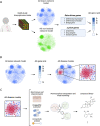Integrative network analysis suggests prioritised drugs for atopic dermatitis
- PMID: 38229087
- PMCID: PMC10792836
- DOI: 10.1186/s12967-024-04879-4
Integrative network analysis suggests prioritised drugs for atopic dermatitis
Abstract
Background: Atopic dermatitis (AD) is a prevalent chronic inflammatory skin disease whose pathophysiology involves the interplay between genetic and environmental factors, ultimately leading to dysfunction of the epidermis. While several treatments are effective in symptom management, many existing therapies offer only temporary relief and often come with side effects. For this reason, the formulation of an effective therapeutic plan is challenging and there is a need for more effective and targeted treatments that address the root causes of the condition. Here, we hypothesise that modelling the complexity of the molecular buildup of the atopic dermatitis can be a concrete means to drive drug discovery.
Methods: We preprocessed, harmonised and integrated publicly available transcriptomics datasets of lesional and non-lesional skin from AD patients. We inferred co-expression network models of both AD lesional and non-lesional skin and exploited their interactional properties by integrating them with a priori knowledge in order to extrapolate a robust AD disease module. Pharmacophore-based virtual screening was then utilised to build a tailored library of compounds potentially active for AD.
Results: In this study, we identified a core disease module for AD, pinpointing known and unknown molecular determinants underlying the skin lesions. We identified skin- and immune-cell type signatures expressed by the disease module, and characterised the impaired cellular functions underlying the complex phenotype of atopic dermatitis. Therefore, by investigating the connectivity of genes belonging to the AD module, we prioritised novel putative biomarkers of the disease. Finally, we defined a tailored compound library by characterising the therapeutic potential of drugs targeting genes within the disease module to facilitate and tailor future drug discovery efforts towards novel pharmacological strategies for AD.
Conclusions: Overall, our study reveals a core disease module providing unprecedented information about genetic, transcriptional and pharmacological relationships that foster drug discovery in atopic dermatitis.
Keywords: Atopic dermatitis; Biomarkers; Disease module; Drug discovery; Network analysis.
© 2024. The Author(s).
Conflict of interest statement
The authors declare no competing interest.
Figures





Similar articles
-
Identification of novel immune and barrier genes in atopic dermatitis by means of laser capture microdissection.J Allergy Clin Immunol. 2015 Jan;135(1):153-63. doi: 10.1016/j.jaci.2014.10.037. J Allergy Clin Immunol. 2015. PMID: 25567045 Free PMC article.
-
RNA sequencing atopic dermatitis transcriptome profiling provides insights into novel disease mechanisms with potential therapeutic implications.J Allergy Clin Immunol. 2015 May;135(5):1218-27. doi: 10.1016/j.jaci.2015.03.003. Epub 2015 Mar 31. J Allergy Clin Immunol. 2015. PMID: 25840722
-
Use of Tape Strips to Detect Immune and Barrier Abnormalities in the Skin of Children With Early-Onset Atopic Dermatitis.JAMA Dermatol. 2019 Dec 1;155(12):1358-1370. doi: 10.1001/jamadermatol.2019.2983. JAMA Dermatol. 2019. PMID: 31596431 Free PMC article.
-
Atopic dermatitis stratification: current and future perspective on skin and blood transcriptomic and proteomic profiling.Expert Rev Clin Immunol. 2024 Sep;20(9):1083-1088. doi: 10.1080/1744666X.2024.2323964. Epub 2024 Mar 4. Expert Rev Clin Immunol. 2024. PMID: 38436065 Review.
-
Atopic dermatitis: Role of the skin barrier, environment, microbiome, and therapeutic agents.J Dermatol Sci. 2021 Jun;102(3):142-157. doi: 10.1016/j.jdermsci.2021.04.007. Epub 2021 May 2. J Dermatol Sci. 2021. PMID: 34116898 Review.
Cited by
-
Computational Drug Repositioning in Cardiorenal Disease: Opportunities, Challenges, and Approaches.Proteomics. 2025 Jun;25(11-12):e202400109. doi: 10.1002/pmic.202400109. Epub 2025 Jan 31. Proteomics. 2025. PMID: 39888210 Free PMC article. No abstract available.
-
Comparing gene-gene co-expression network approaches for the analysis of cell differentiation and specification on scRNAseq data.Comput Struct Biotechnol J. 2025 Jun 6;27:2747-2756. doi: 10.1016/j.csbj.2025.05.040. eCollection 2025. Comput Struct Biotechnol J. 2025. PMID: 40673123 Free PMC article.
References
Publication types
MeSH terms
Substances
Grants and funding
LinkOut - more resources
Full Text Sources

